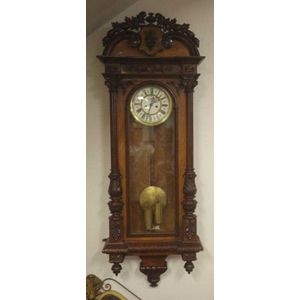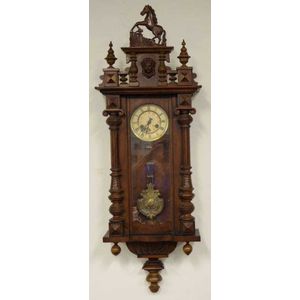Antique German Junghans Regulator Wall Clock with Carved Case
You must be a subscriber, and be logged in to view price and dealer details.
Subscribe Now to view actual auction price for this item
When you subscribe, you have the option of setting the currency in which to display prices to $Au, $US, $NZ or Stg.
- Movement - The technical name for the workings of a clock or watch, and does not include the dial or case.
- Pendulum - The pendulum was discovered around 1602 by Galileo Galilei, and was adopted for time keeping by the Dutch mathematician and natural philosopher, Christiaan Huygens, who excelled in astronomy, physics, and horology.
The pendulum comprises a metal rod usually of brass or steel with a metal disk, known as a bob, at the end. The movement of the pendulum is driven by weights or a spring, and as a pendulum swings in a regular arc, it was found accuracy could be controlled to within a few seconds a week.
Timekeeping can be adjusted by changing the height of the bob on the rod, making the pendulum either swing slower or faster.
The disadvantage of the pendulum was that changes in temperature also changed the length of the pendulum, interfering with the accuracy of the clock, and so in the 18th century two types of mercurial pendulums were invented which countered the movement in the steel rod.
The pendulum was the world's most accurate timekeeping technology until the invention of the quartz clock, regulated by a quartz crystal, in 1927.
This item has been included into following indexes:
-
clocks, type
- regulator, wall mounted 87
- wall 829
- Junghans Uhren GmbH (Germany) - clocks and watches 98
Visually similar items

A late Victorian walnut cased three train bracket clock signed Webster / Queen Victoria St / London / 17726 with a triple fusee anchor escapement, gong and striking on eight bells, the silvered floral engraved Roman numeral dial and subsidiaries for chime/

A French walnut regulator wall clock. 112 cm high, 42 cm wide, 16 cm deep

Gustav Becker Vienna wall clock, with weight driven movement, key and pendulum included, 145 cm high

A George III musical bracket clock, J Thwaites, London, circa 1811, the mahogany brass lined bell top case with rococo finials, each angle mounted with brass herms trailing leafy buds. The sides with brass handles above foliate case sound frets with quarte
